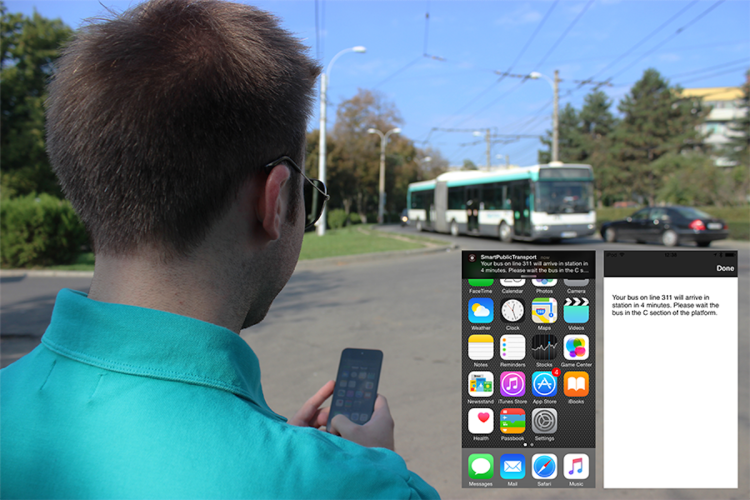Beacons have become known among marketers as store location-pingers for mobile device users who might welcome aisle-appropriate coupons.
But a startup’s new project in Bucharest, Romania highlights their potential as a vital service in environments that themselves are mobile — public transportation.
Onyx Beacon, which is based in the Transylvanian capital city of Cluj-Napoca, is today launching a project that employs 500 iBeacons on the sides of city buses and trolley cars to assist visually impaired passengers.
The company says that, to its knowledge, this is the first project of its kind.
Mounted on the outside of each bus, a beacon emits via Bluetooth Low Energy its unique location identifier when it is within about 180 feet of a bus stop.
The project’s app, installed on the iOS or Android smartphone of a visually impaired person waiting at the bus stop, responds by pushing a notification to the passenger’s home screen that “bus number 24 has arrived,” even if the app is not open. There is also a unique audio signal emitted by the phone.
Marius Mornea, chief technology officer at Onyx, told me that most such passengers employ text-to-speech readers on their phones, so the notification can be spoken to them. As is normally the case with beacons, updated communications to the passengers — such as current bus schedules or the number of the approaching bus — require a Wi-Fi or cellular data connection.
The challenges of bus beacons
The beacon is specially designed for outdoor use, remote monitoring, and connection to a buzzer on the outside of the bus, which helps the passenger find the arriving bus. There are sixteen different buzzer sounds, so the passenger can choose one. If several buses for waiting visually impaired passengers arrive at once, the bus plays all of the selected buzzer sounds in a sequence. When the passenger boards the bus, the notification and buzzer(s) stop.
A test version of the program, which is funded by the Vodafone Foundation, began in June with the installation of 40 beacons and the participation of about two dozen passengers. It was initiated when an organization serving visually impaired people approached Onyx last winter. Seven thousand passengers in Bucharest are registered as visually impaired, and another 5,000 are estimated to have some sight problems.
But bus-based iBeacons pose a variety of challenges, as proximity marketer iSign Media pointed out to me. That Toronto-based company is currently deploying a proximity project for buses in Cleveland, Ohio, but it has chosen to use its own, beacon-like technology called Smart Antenna.
Bus-based beacons, the Canadian company noted, fall off or are stolen, have short-lived battery lives, and have very limited ranges — plus only a few passengers will have the required app. iSign’s own browser-based solution has a greater range of up to 300 feet, and is thus expected to reach 90 percent of passengers.
But the Bucharest project’s needs match beacons’ limitations. Those adapted beacons only need to function as the buses are coming to a stop, they have been adapted for remote monitoring of battery life and other functions, they can run off the buses’ electrical systems, and the visually impaired passengers have an incentive to download the app.
This is the first wide-scale implementation of a number of public transportation projects Onyx has in the works. One, a trial project in Abu Dhabi, puts beacons literally in the role of lifesavers.
In that effort, Onyx has provided beacons on keychains for a classroom of students, so teachers and school personnel can test whether this solution can help keep track of the group. Each keychain-with-beacon runs about $20.
Tragic accident
This trial follows a tragic accident in that country in October of last year, when a four-year-old girl was accidentally locked in a school bus and died of heat exhaustion and suffocation.
The class attendant and driver had dropped off the other students to school in the morning, but didn’t realize the young girl was sleeping in a rear seat. Four people were convicted of negligence, fined, and sentenced to jail terms ranging from six months to three years.
Onyx, which was founded last year and has been bootstrap-funded so far, is now releasing an Extended Version of the bus beacon program that is intended for all passengers.
It will provide 16 new functions, including real-time pricing for certain routes, individual route calculations, emergency re-routing, monitoring of kids or seniors on field trips, and contextual advertising.
The company said it is also working on a beacon project with the London Tube, and is in discussion with public transportation officials in nearly a dozen cities worldwide.
But, while public transportation opportunities are expanding for the firm, this has not been its main focus.
Mornea told me the 20-person firm is generally interested in large-scale, location-based communications and marketing. It has a partnership with IBM to provide beacon-based services on the technology giant’s Bluemix platform-as-a-service, and it has deployed 600 beacons for French retailing giant Carrefour.
VentureBeat's mission is to be a digital town square for technical decision-makers to gain knowledge about transformative enterprise technology and transact. Learn More

